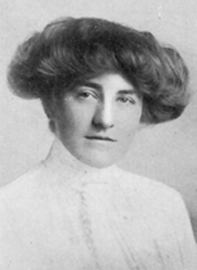Name Frances Stevens | ||
 | ||
Frances Simpson Stevens (1894-1976) American painter, is remembered as one of the only Americans to directly participate in the Futurist Movement. Stevens was also one of the artists who exhibited at the landmark show Armory Show in New York City. The show included her oil painting Roof tops of Madrid ($200).
Contents
Early life
Stevens grew up in Chicago, Illinois. Stevens graduated from Dana Hall School in Wellesley, Massachusetts, and moved to New York City. In 1912 she attended a summer painting class taught by Robert Henri in Spain. It was there that she painted The roof tops of Madrid, the painting that she would exhibit a year later in the Armory Show.
Following the closing of the show, at the urging of Mabel Dodge, Stevens moved to Florence where she rented a studio from 1913 to 1914 with Mina Loy, who had asked Dodge to find her a boarder. Stevens and Loy became fixtures in the local art scene and it was there that they became acquainted with Marinetti and the Futurists. Stevens was the only American to exhibit at the 1914 Esposizione Libera Futurista Internazionale, where she showed eight works.
Stevens was active in World War I. After leaving Europe she returned to New York where she published a series of cartoons in Rogue magazine. She also exhibited in New York, receiving a positive review in the New York Times.
Futurism
Stevens explicitly identified her work as futurist. In an article for The Popular Science Monthly, she articulated her vision:
"A futurist artist in Italy, seeing an ordinary street car go by, realizes the future possibilities of power and speed, and he begins to paint great trains going so fast that they lose their definite form in the lines of direction. Motion and light destroy the solidity of the material bodies... The futurists make their engines move, throb and create. Something is always happening in a futurist's pictures, and the great variety of color and changing lines helps to convey this impression." Frances Simpson Stevens, 1917
Very little of Stevens' art has survived. One work that has is Dynamic Velocity of Interborough Rapid Transit Power Station at the Philadelphia Museum of Art.
Later life
The New York Times reported that "Miss Frances Simpson Stevens of this city became the bride of Prince Dimitry Golitzine" on April 19, 1919, under the headline "MISS STEVENS WED TO RUSSIAN PRINCE". American Art News reported on the marriage as well, styling the groom "Prince Dimitrioff Nicholaevitch Galitzine", and identifying him as a son of the last Prime Minister of Russia, Prince Nikolai Dmitriyevich Golitsyn. They had reportedly met at a dinner, when the Prince was attached to the Russian Embassy in Washington. They were married in a registrar's office. Frances was latterly styled Princess Dimitry Golitzine. After honeymooning in California, the couple departed for Vladivostok, where the Prince had a naval command, travelling by way of Japan. Frances was his second wife; his first wife was killed in revolutionary Russia in 1918.
Stevens and her husband lived in Siberia for two years during the Russian Civil War. They were in Omsk while the Kolchak government was in power there, and later escaped from Vladivostok to Japan on the Russian warship Oriole, whose men were loyal to the Kerensky government. The couple returned to America, arriving in Boston on August 14, 1920, on the British steamship Persian Prince, via China.
Stevens apparently continued her artistic activities for at least some time after her return to New York. Prince Dimitri Golitzine (or Golitsyn) (born 11-03-1882 Arkangelsk, Russia) died 5-12-1928 in Nice, France. Little is known about Stevens' life after her return to America; she died in a residential care home as a ward of the State of California in 1976.
